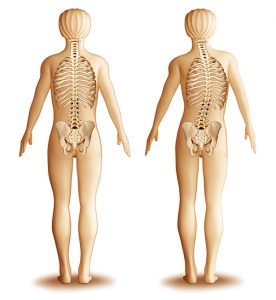Spinal Deformity

Spinal Deformities
There are several different conditions that can cause a deformity of the spine. A spinal deformity is actually a symptom in which the normal curves of the spinal column become exaggerated, or the vertebral column may develop a lateral curve. Scoliosis is the most common spinal deformity in which the spinal column develops a lateral curve, or bends in a lateral direction, usually in the mid-section or thoracic area of the spine. What causes scoliosis is many times unknown. Sometimes spinal deformities are present at birth (congenital). Other causes include abnormally formed vertebrae, paralysis of the muscles on one side of the spine, chronic low back and lower leg pain, poor posture, and uneven leg length.
Spinal Deformities: Scoliosis
Spinal Deformities: Osteoporosis
-
- -hormone imbalances or deficiencies
- -A lack of calcium
- -A lack of vitamin D
- -A sedentary lifestyle is associated with osteoporosis
- -Other medical conditions like thyroid disease or certain digestive disorders
- -Tobacco use can lead to osteoporosis
- -Excessive consumption of alcohol
- -Use of certain medications can lead to osteoporosis
- -There is also a genetic risk factor that has been linked to the development of osteoporosis
Spinal Deformities: Kyphosis
This spinal deformity is characterized by the pronounced rounding of the upper back. Mild forward rounding in the upper area of the spine is normal, but in this condition, the rounding is exaggerated. It is possible for kyphosis to occur in either sex and at any age, but it most commonly develops in women who are post-menopausal.
Spinal Deformities: Lordosis
Kyphosis: This spinal deformity is characterized by the pronounced rounding of the upper back. Mild forward rounding in the upper area of the spine is normal, but in this condition, the rounding is exaggerated. It is possible for kyphosis to occur in either sex and at any age, but it most commonly develops in women who are post-menopausal.
Mild cases of kyphosis rarely cause problems, but in more severe cases, the deformity can be painful as well as disfiguring. Kyphosis that is related to aging usually happens when the bones of the spine (vertebrae) are weakened by osteoporosis, causing them to crack and collapse. Besides age-related kyphosis, other types of the condition sometimes occur in infants or teenagers. In these cases, the curve is caused by a malformation of the vertebrae or is due to the vertebrae wedging into improper alignment over time.
The treatment for kyphosis depends on what is causing the condition, the symptoms it is producing and the age of the patient.
Lordosis: This deformity is sometimes known as "swayback". In lordosis, the lumbar curve of the spinal column, in the lower back, curves excessively inward. Many different conditions or situations may lead to the development of lordosis. It may be caused by pregnancy or by obesity, due to significant abdominal weight. Other possible causes include osteoporosis, rickets, poor posture, and spondylolisthesis.







